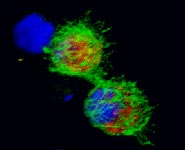A mathematical model by Dr Krasimira Tsaneva-Atanasova, Lecturer in the Department of Engineering Mathematics and Craig McArdle, Professor of Molecular Pharmacology in the School of Clinical Sciences, that challenges conventional wisdom regarding pulsatile GnRH signaling is published ahead of print in the Journal of the Royal Society Interface (June 2011 ePub).
The mechanisms underlying cellular pulse frequency decoding are poorly understood. In this system, a small number of neurons in the brain secrete a protein hormone (gonadotrophin-releasing hormone – GnRH) that acts on cells in the pituitary gland to stimulate the synthesis and secretion of two gonadotrophin hormones (LH and FSH). These, in turn, control production of egg cells and sex steroid hormones in the gonads and in this way, GnRH mediates central control of reproduction. GnRH is secreted in bursts (normally pulses of a few minutes duration every 30 minutes to eight hours in humans) and its effects are dependent upon pulse frequency.
Pulsatile GnRH drives pubertal development and also causes the cyclical surge in protein hormone secretion that drives ovulation in women, but when pulse frequency is too high this can reduce protein hormone secretion, causing a chemical castration that is used in the treatment of steroid hormone dependent cancers. In essence, the physiology and therapeutic manipulation of the reproductive system is underpinned by bell-shaped frequency response relationships in which sub-maximal GnRH pulse frequencies elicit maximal responses.
The mechanisms explaining this relationship are largely unknown but researchers have begun to use mathematical and wet-lab modeling approaches to solve the problem. For many years negative feedback has been assumed to underlie reduced responses at high pulse frequency and the McArdle lab have used a live cell imaging approach to test for such feedback. By expressing signalling proteins tagged to fluorescent marker proteins, effects of GnRH on two signalling pathways (ERK and NFAT pathways) were monitored during trains of GnRH pulses and the anticipated negative feedback simply didn’t occur (Armstrong et al. 2009,2010).
Dr Tsaneva-Atanasova then developed a mathematical model for GnRH signalling that faithfully mirrors the wet-lab data. Extending the model to predict effects of pulsatile GnRH on gonadotrophin synthesis predicted bell-shaped frequency-response relationships when the two pathways converge in a co-operative manner at gene promoters. In this way genuine frequency decoding occurs as an emergent feature of the signalling network, even when individual proteins or modules within the network do not function as stand-alone frequency decoders.
Dr Tsaneva-Atanasova said: “The direct importance of our work lies in the potential for greater understanding of GnRH signalling with physiologically relevant stimulation paradigms and identifying new drugs that could be used for fertility control and the treatment of hormone-dependent cancer.”
The mathematical provides a novel insight into pulsatile GnRH signalling by showing how genuine frequency decoding could occur without the negative feedback thought to underlie. Since the signal architecture modeled is extremely common in cell signalling networks the finding may well have broad application to numerous systems.
This work also illustrates the potential value of collaboration between mathematicians and biomedical researchers. Dr Tsaneva-Atanasova and Professor McArdle are both core members of the University’s Predictive Life Sciences theme. Petros Mina, a project student working on an MSc programme in the Bristol Centre for Complexity Sciences, did the initial mathematical modeling. Most importantly, the mathematical modeling has provided not only novel mechanistic insight into the system, but also a series of testable hypotheses that form the basis of an ongoing MRC-funded project on GnRH pulse frequency decoding.
Paper: Decoding GnRH neurohormone pulse frequency by convergent signalling modules by Krasimira Tsaneva-Atanasova, Petros Mina, Christopher J. Caunt, Stephen P. Armstrong and Craig A. McArdle, J. R. Soc. Interface published online 15 June 2011 doi: 10.1098/rsif.2011.0215.
